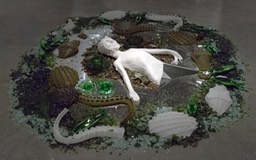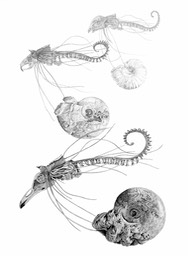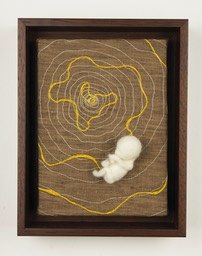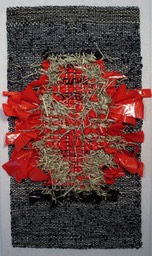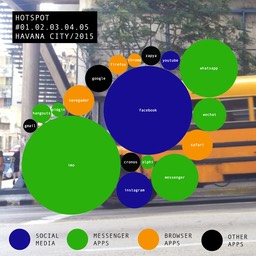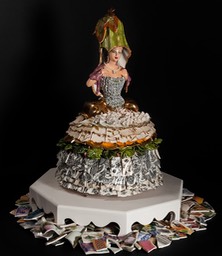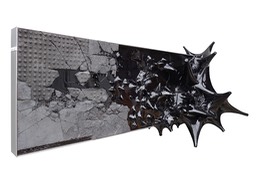SAMPLING of Current Bakehouse Artist Profiles and Videos
Judith Berke King
Kyoko Matsuyama
Rodolfo Peraza
Troy Simmons
Wynwood’s True Artistic Pioneer Turns 30
“Under new management” is a fitting slogan for the Bakehouse Art Complex, which hired executive director Bibi Baloyra and associate director of exhibitions and education Yuneikys (Yuni) Villalonga this spring — on a fast track to plan both a 30th anniversary celebration (February 2017) and a two-year exhibition program.
Arlys Raymond, who served as executive director from 2006-2013, oversaw major facility upgrades while raising the organization’s profile. She returned to pilot the search for new leadership and assisted their bonding with an enthusiastic legacy team.
The BAC, in northwest Wynwood, features 65 studios, two galleries and stations for welding, woodworking, printmaking, photography and ceramics. It houses visual arts activities as time-honored as Kyoko Matsuyama’s wool felting and as high-tech as Rodolfo Peraza’s digital traffic visualizations.
Both new administrators have extensive curatorial and managerial experience in New York and abroad. Returning to Miami “feels like coming home,” Villalonga said. “It’s just a perfect challenge to take what I’ve been calling ‘a tired lady who needs to be wakened up, [get] her hair brushed, a little makeup and she’s good to go,’ ” laughed Baloyra in an August interview. They were eagerly inviting current and former board members, founders and friends to contribute both to the organization’s material archive and to the conversation about what they would like to see. Between the artists and other supporters, “It’s a very rich ecosystem,” Baloyra said.
Villalonga will review this material and curate an exhibition — hopefully in collaboration with partners, such as FIU’s curatorial practice students. For this major celebration, both the larger Audrey Love and smaller Swenson galleries will be used. They also plan an oral history project, partnering with HistoryMiami.
HISTORY
The BAC founding roster included Helene Muller Pancoast, Faith Atlass, and Nathalie and David Nadel. They spearheaded a large group of artists — many from Coconut Grove, once Miami’s counter-culture hub. Grove House was a prime exhibition and gathering space for regional artists, who became frustrated by its forced relocations. “We all decided we weren’t going to do that again,” recalled Pancoast. She is helping to flesh out BAC history and is eager to appraise its evolution since her total immersion at the project’s inception.
The Torpedo Factory Art Center in Alexandria, Virginia, founded in 1974, helped model both the BAC and South Florida Art Center, where ceramist Ellie Schneiderman was the leader, first renting and eventually purchasing storefronts on Miami Beach’s then-decrepit Lincoln Road.
BAKERY TO ART COMPLEX
In 1986, “discovery” of the inactive, 32,000-square-foot American Bakeries Company building catalyzed the second cadre of the search committee to focus there. Its location in a distressed neighborhood incentivized city administrators to support the fledgling nonprofit through a Community Development Grant program and motivated the building’s owners to reduce the sale price by 75 percent from its $900,000 appraised value. The neighborhood was rough, recalled Atlass, referencing nearby drug-dealing, “but the price was right. David [Nadel] did most of the bargaining and negotiations.”
The building had “good bones.” Pancoast’s late husband, Lester, was a respected architect and watercolorist. His firm, Pancoast Albaisa architects, assigned young employee Joaquín Rodriguez to manage pro-bono planning and construction oversight. Wide open, “it was just a matter of putting in partitions and leaving the top open for ventilation,” Pancoast said.
“The original board was great,” she added. “They went out, spread the word, got it out in the community and got the money coming in.” That money, including funds from the city and county, was devoted to the construction project. Atlass’ husband, Alvin, convinced a Canadian company to donate doors and locks. “It was done on shoestrings, amazingly enough,” she said. There were also setbacks, as when fuel storage tanks had to be removed and burglars stole copper wire and pipe worth thousands.
The space was big enough to have 72 studios available … bang,” Pancoast said. The Ceramic League, where Jean Waldberg was a leader, hosted exhibitions and was instrumental in outreach. Advertising was unnecessary. Waldberg was also involved in real estate and helped establish rental rates and leases. The South End Alternative Theater rented a black-box space on the second floor. Plays, music and other performances coincided with Second Sunday open house evenings. Later, the M Ensemble Theater moved in.
Vivian Rodriguez, an art historian, had project management and cultural tourism experience when hired as director in early 1987. She and Haitian-born custodian Joe Gedeon were the only two paid staff members. He remains in that capacity and has befriended and assisted everyone along the way.
It was a period of all hands on deck. “You just sort of did what you had to do,” Rodriguez said, “from managing projects to renting the studios to troubleshooting to going out and buying supplies, to doing promotional work, dealing with the press.” Volunteers organized committees for exhibitions, educational programming, public events, fundraising, publicity, etc.
“We had a loan from the city of Miami and we had a loan from the county, which were like mortgages, and a huge fiscal challenge,” Rodriguez said. Through informal lobbying and engaging officials in BAC events (what Atlass called the “dog and pony show”), she, Pancoast and other backers eventually convinced both governments to convert the dept into a capital grant.
Providing affordable studio space was — and remains — fundamental. Rentals, always discounted, still provide the principal income stream. Rates are set by calculating square footage, location, and amenities like water and light. The National Endowment for the Artspartially underwrites rent for four artists — sometimes providing their first experience working outside the home.
Grants and private donations supplement the costs of professional workshops, lectures, panels, open houses and demos. Artists are independently juried in, and currently there’s a waiting list. Associate status allows nonresident artists to participate in exhibition programming and other activities.
Rodriguez suggested that some artists who chose the BAC over Lincoln Road prioritized privacy over likelier walk-in sales. A boon of everyone being under one roof was, “If you closed your door, people knew your were working, but you could also open up and share ideas.”
Some artists taught or had other day jobs, but many were in their studios full-time. Threshold Gallery, featuring ceramics, leased a space; Pat Taylor ran a jewelry school and gallery. “These ongoing entities kept a lively daily traffic,” Rodriguez said.
The Audrey Love Gallery, named after a major benefactor, was built out during Rodriguez’s tenure. It showcases resident artists and houses thematic exhibitions organized by invited curators. Swenson Gallery offerings — exhibitions, films, demos and lectures — generate synergy with the larger shows.
NEW LEADERSHIP
Partly because her forebears’ worldly goods were abandoned in Cuba, Baloyra “was interested in material culture and the decorative arts.” She found a sweet spot in art history at the University of Miami, “looking at slides of places and things that were otherwise not in my reach.” Fifteen years as a purchasing agent in New York’s fashion industry drew on her design sensibilities and cultivated business savvy. Positions with the U.N. and Qatar’s National Museum honed her administration skills. She quips: “Procurement and bureaucracy [in Doha] were on a whole other level!”
Hispanic-Caribbean and Cuban art were Villalonga’s concentrations during her university studies and teaching. As curator for a Havana-based nonprofit and then working independently, she organized exhibitions “to insert contemporary Cuban art — which I knew the best — into a more international dialogue.” This included extensive work in Eastern Europe, Sweden and Britain — plus five years at the Lehman College Gallery in New York.
NEW PROGRAMMING
Freda Tschumy’s recently concluded solo exhibition paid homage to the highly accomplished steel and bronze sculptor and painter. It ran alongside “Monolith: Abasi Rosborough Collection,” inspired by a sculptural installation in the Qatari desert. Public art and entrepreneurship were subtexts for this pairing. Said Baloyra: “We’re working to formalize a relationship with the Underline Project so that the Bakehouse becomes the creative ground zero for artists who are responding to requests for proposals.”
Political cartoonist Jim Morin returns to Miami to celebrate and skewer the election season during a multifaceted November fundraising program. A selection of 50 examples from recent years will be on view in the Swenson Gallery. “Autopia: Road Trips from the Cold War to the Present” will glorify and critique car culture with exhibitions and collateral events, coinciding with Miami’s most traffic-challenged period: Art Week. The exhibition, curated by Gabriela M. Fernández and Elvis Fuentes, will also be the focus of “Art Camp,” an educational program designed to fill holiday and teacher planning-day gaps in the public school year’s art schedule. Plans are in development to revive the relationship with Arts for Learning and reach out to special-needs and foster children.
Florida International University’s curatorial practice program already uses an upstairs gallery to mount monthly shows. “We’re working to deepen that relationship,” Baloyra said.
The nearby Institute for Contemporary Art is another potential “friend.” Baloyra read that they recently received $5 million to acquire new art. “Let’s hope their curators walk through here at least once in that consideration.” She added that offering professional enhancement workshops could benefit stakeholders of both institutions.
The new directors have scant downtime. “My husband is an artist; all our friends are artists; all we do is art, so it’s little bit vicious,” Villalonga joked. Her escape: fishing.
For Baloyra, fleshing out the “phantom” Aunt Bibi, who disappeared for two decades, is a priority — plus travel planning.
Sampling of current artist profiles.
IF YOU GO
What: ‘Lucky Us? Pre-election Art Therapy,’ fundraising silent auction, solo exhibition featuring political cartoonist Jim Morin and editorial cartoon workshops by a Bakehouse resident artist
Where: Bakehouse Art Complex, 561 NW 32nd St., Miami.
When: Oct. 29-Nov. 4. Exhibition and Event Calendar, including Art Week: see Calendar (bit.ly/BAC-Calendar)
Oct 24-Nov. 3, Online Auction bitly.com/LuckyUS-Auction
4-6 p.m., Nov. 1: Editorial cartoons workshop for youth ages 13-16. Registration: $60.
7-9 p.m. Nov. 2: Opening reception ‘Between Ballots 2013-16: Art + Culture in America by Jim Morin.’ Free and open to the public
4-7 p.m. Nov. 3: Editorial cartoons workshop for adults. Registration: $75
7-11 p.m. Nov. 4: Lucky US? ‘Art Therapy’ fundraiser party and curated auction including four works by Jim Morin and many other therapeutic surprises. Tickets $60 in advance, $75 at the door.bacfl.org, 305-576- 2828, info@bacfl.org
Read more here: http://www.miamiherald.com/entertainment/visual-arts/article110832992.html#storylink=cpy
https://archive.org/help/audio.php?identifier=BACArtistProfiles
